On September 9, Director of the India Project Tanvi Madan testified before the U.S.-China Economic and Security Review Commission Hearing on “U.S.-China Relations in 2020: Enduring Problems and Emerging Challenges.” Download or read the full testimony below.
Chairman Cleveland, Vice Chair Bartholomew and Members of the Commission, thank you very much for your invitation to testify on the China-India boundary crisis and its implications.1
The China-India relationship has had elements of cooperation, competition and potentially conflict. When they met in October 2019, Chinese leader Xi Jinping and Indian prime minister Narendra Modi sought to stress the cooperative elements in the relationship, which the two countries have tried to increase over the last two decades. However, since the beginning of the year, the novel coronavirus pandemic and the boundary crisis have ensured that the competitive and conflictual elements of the Sino-Indian relationship have dominated—and are likely to persist, if not increase. Recent developments have demonstrated that despite Delhi and Beijing’s efforts to engage and to stabilize their relationship, it remains a fundamentally competitive one that can spillover into conflict.
Motives, Timing & Assessments
Motives: The motivations for the People’s Liberation Army’s initial moves at the China-India Line of Actual Control (LAC) in May, which Delhi saw as a unilateral attempt to change the status quo, are still a subject of debate. Analysts have put forth various possibilities: a Chinese effort to incrementally salami-slice or nibble its way to additional territory and present India with a fait accompli; a desire to put India in its place; concerns about Indian infrastructure building; Delhi changing the status of Ladakh (separating it from Jammu & Kashmir, and centrally administering it); or as a warning against India further deepening its relations with the U.S. and its allies.
Others have noted that the PLA action at the LAC did not occur in isolation and have pointed to a broader pattern of Chinese assertiveness over the last few months. Along with moving forward with the National Security Law in Hong Kong, Beijing has also seemed to target imports of barley, beef and wine from Australia. Canberra has also revealed major cyber-attacks on various organizations, with some officials confirming China as the culprit.2 Japan, in turn, has flagged daily Chinese coast guard activity near the Senkaku Islands and “suspicious aircrafts heading to Japan’s airspace” more frequently as subjects of concern.3 Taipei has complained about increased Chinese military activity in its vicinity.4 Hanoi, on its part, has objected to Chinese vessels ramming—and in one case sinking—Vietnamese fishing boats in the South China Sea (SCS).5 There were also reports of maritime harassment against other SCS claimants (Malaysia, Philippines).6 In addition, Chinese coast guard and fishing vessels operating off the Natuna islands resulted in a stand-off with Indonesia.7 And Beijing charged two Canadians for spying—and linked their 18-month detention to the Canadian detention of the chief financial officer of Huawei.8 Meanwhile, a number of European countries and the United Kingdom have been subjected to coercive rhetoric from China’s “wolf warrior” diplomats.9
There is a debate about whether this Chinese assertiveness on a number of fronts, including against India, is stemming from (a) Xi Jinping acting out of insecurity, given domestic concern and international criticism of his regime’s handling of the coronavirus pandemic, and wanting to demonstrate resolve or strength,10 or (b) Beijing’s desire to take advantage of other countries, including the United States, being on the backfoot or distracted due to the coronavirus.11
On the Chinese actions against India, former Indian national security advisor and ambassador to China Shivshankar Menon has suggested the first is at play, noting that “China has a pattern of risk-taking behavior at times of domestic crisis.”12
As far as the Indian government is concerned, external affairs minister S. Jaishankar has said, “frankly, we are at a loss to know why” Beijing has taken this approach.13
One thing that does seem clear, given the scale of the initial PLA deployment and activity, is that these movements were neither accidental nor the result of a local commander’s initiative. What is still not clear is what led to the the clash of June 15 that resulted in the first fatalities on the China-Indian boundary in 45 years.
Timing: The timing of the PLA’s actions was not surprising. The weather and terrain in the area mean that there is a window for such activity from around May to September each year.14 This is also the period during which the two sides undertake military exercises on their respective sides of the LAC. This year, India postponed its exercise due to the pandemic. However, after a short delay, China did conduct its annual spring military exercise. Indeed, the PLA is reported to have undertaken its initial moves to change the status quo at the LAC by redeploying its troops involved in this exercise. On the other hand, the Indian postponement meant that its military did not have a presence in matching strength on its side of the LAC, which the PLA could have seen as an opportunity to act before India had a chance to move troops from other locations.
Evaluating outcomes: It is difficult to assess how Beijing might be evaluating the success of its actions without a better sense of its motivations. If, for instance, its goals were to acquire territory and consolidate its claims, presenting India with a fait accompli and changing the LAC, it might deem the moves a success (though this is still an ongoing situation and the final disposition is as yet unclear). If Beijing’s objectives were to stop or dissuade Indian infrastructure building on its side of the LAC, reverse Indian moves in Ladakh, or deter Delhi from a closer relationship with the US and other partners, then the Chinese moves have been ineffective, if not counterproductive. Furthermore, they have fueled concerns in a number of countries of an assertive, if not aggressive China that is willing to risk escalation and challenge the rules-based order. Finally, if Chinese policymakers’ idea was to make tactical gains while keeping the broader China-India relationship intact, recent developments should have put paid to that expectation.
Impact on Indian Perceptions & the Sino-Indian Relationship
China has publicly sought a return to business as usual in the relationship. Wang Yi and other officials have called for the border issues to be placed in “a proper place in bilateral ties.”15 However, while Beijing is seeking a restoration of the status quo ante in the relationship, Delhi has made clear that what it wants is a restoration of the status quo ante at the boundary (i.e. the PLA to return to its positions as of late April). Government officials have stressed that the boundary issue and the broader relationship cannot be separated, asserting that the “maintenance of peace and tranquility in border areas is sine qua non for progress in [the] rest of [the] bilateral relationship.”16
Even as their militaries remain deployed in large numbers at frontline positions, the two countries’ military and diplomatic officials are engaged in dialogue. However, former Indian foreign secretary Shyam Saran asserted in July that “tensions may subside, but the relationship will never be the same again.”17 The suggestion is that Delhi might return to engaging Beijing in the future, but even the nature, extent and expectations of that engagement will change.
For now, tensions have not subsided and the longer the boundary crisis continues, the greater its impact will be on the broader Sino-Indian relationship.
Impact on perceptions: Together with the coronavirus pandemic and its health and economic consequences, the boundary crisis has already had an effect on Indian perceptions. The Indian ambassador to China has noted the considerable damage to India’s trust in China. Moreover, the recent developments have reinforced and even accelerated existing Indian concerns about China (some of which have existed since the mid-to-late 1950s).18
In the foreign and security policy establishment, there are widespread calls for a reassessment of India’s China policy. The boundary crisis—and particularly the fatal clash in June—has resulted in a remarkable convergence among the Indian government’s former China hands on the ideas of a watershed moment, of significant damage to Sino-Indian ties, of a more adversarial relationship in the future, and of the need for India to build its strength and its partnerships further to tackle China. This contrasts with the messaging coming from Chinese officials who have stated that “the orientation of China and India as partners, friendly cooperation and common development remain unchanged.”19
Indian public sentiment on China, already turning sour due to the pandemic, also deteriorated further because of the killing of Indian soldiers in June. Among other things, this has resulted in calls to boycott Chinese products, partners and sponsors.20
More significantly, the boundary crisis has hardened official views of China in India. The Indian home minister has linked China both to the boundary and health crises affecting the country. The Indian external affairs minister told his China counterpart after the June 15 clash, “this unprecedented development will have a serious impact on the bilateral relationship.”21
Furthermore, the Indian government has called the Chinese “actions and behavior” a “clear violation of the bilateral agreements and protocols concluded between the two countries” over a two-decade period from 1993.22 And the external affairs has added a reminder that, despite a boundary dispute that dates backs decades, “It was because of these agreements and the adherence to them that the bilateral relationship moved forward in other, different spheres, including the economic one.”23
The boundary crisis indeed seems to have weakened the hands of those in Indian policymaking circles that argued for more engagement with China or for the idea that economic ties would help alleviate political strains.
Policy consequences: Thus, beyond rhetoric, there have already been policy consequences. These have resulted from the intensification of Indian concerns about (a) economic overdependence on and exposure to China, (b) inroads that Chinese companies—particularly those with close links with the state—have made into certain Indian economic sectors that are sensitive, and (c) avenues of Chinese influence in the country. This has led to a slew of measures that will restrict or scrutinize Chinese activities in the economic, technology, telecommunications, public diplomacy and education sectors.
Even before the boundary crisis, the Indian government had announced restrictions on foreign direct investment from countries that share a land boundary with India—a move clearly directed against China. Furthermore, it reportedly urged the Securities and Exchange Board of India to increase its scrutiny of foreign portfolio investment from China and Hong Kong.24
Since the Chinese actions at the boundary, the Indian government has taken further action. Some have interpreted Prime Minister Modi’s emphasis on atmanirbharta (self-reliance) over the last few months as primarily designed to reduce India’s economic dependence on China. Road Transport, Highways and MSME minister Nitin Gadkari has indeed said, “imports from China will be discouraged and the country will take large strides towards self-reliance.” He also indicated that, within his portfolio, Chinese companies could be excluded from future road construction projects.25
The government has amended public procurement rules “to enable imposition of restrictions on bidders from countries which share a land border with India” on defence and national security grounds.26 And its online procurement platform now requires vendors to identify the country of origin of products.27
There have also been reports of other steps, signals and scrutiny. An Indian state government has put on hold some agreements with Chinese companies, and indicated that the central government has told them “not to sign any further agreements with Chinese companies.”28 Delhi is reportedly considering further measures to curb and scrutinize imports, including to prevent Chinese goods from being routed through third countries.29 There are have also been reports that Indian state-owned oil companies will no longer use Chinese tankers to ship crude oil or petroleum products.30 On a more positive note, the Indian government is providing incentives for Indian and foreign companies to manufacture in India, and to reduce dependence on Chinese imports in particular sectors like solar power, electronics and pharmaceuticals.
Sino-Indian technology sector ties have also been affected. The amendments to Indian investment rules will adversely affect Chinese technology companies interested or operating in India. Moreover, in three tranches, India has banned a number of Chinese apps on the grounds that they are “prejudicial to sovereignty and integrity of India, defence of India, security of state and public order.” These include TikTok, almost a third of whose total downloads come from India, as well as AliPay.31
There has also been an impact on the telecommunications sector. State-owned firms BSNL and MTNL canceled a tender issued in March to upgrade their 4G networks. The revised tender is expected to exclude Chinese firms Huawei and ZTE from bidding to provide equipment.32 There are also reports that the Indian government is ready to use investment restrictions to exclude these companies from India’s 5G trials. This is a shift from the Indian approach earlier in the year when the government had announced that it would permit all vendors, including Huawei, to participate in the trials.33
In addition, after a phase of encouraging travel and exchanges from China, the Indian government seems set to adjust course in this sphere. Delhi is reportedly considering requiring prior security clearance for visas for Chinese business, civil society and academic professionals. Indian institutions’ and universities’ agreements with Chinese organizations, particularly Hanban, are also being reviewed and likely to be discouraged.34
Responses and the Road Ahead
Current responses: The response to these policy changes in India have been mixed. There have been questions about India’s ability to reduce dependence on China, and the costs that will entail—particularly as India deals with the economic fallout of the pandemic. There are also concerns about supply disruptions, especially since Prime Minister Modi has been emphasizing the importance of India playing a greater role in global value chains. Others have questioned the government’s motives, suggesting these moves stem from a protectionist impulse and are reminiscent of pre-liberalization import substitution policies.35 And there has been anxiety in some quarters of the technology sector because China has been a major source of investment for Indian start-ups—by one estimate, two-thirds with a billion-plus-dollar value have at least one Chinese investor. Some of these investments have reportedly been put on hold.36
Former Indian officials have acknowledged that these restrictions will hurt India, but have argued that it is still worthwhile to take these steps to reduce Indian exposure to and overdependence on China—and noted that it might be easier to take these steps when Indians are already feeling economic pain as a result of the pandemic fallout. Gautam Bambawale, a former Indian ambassador to China, also expected these steps to lead to a deterioration of Sino-India ties, but said “so be it.”37 Others have argued that alternative sources of capital and imports exist and should be explored. Indian government officials, on their part, have indicated that they neither expect overnight overcomes nor total decoupling, but stressed the importance of starting the process.
The Chinese response has been a mix of persuasion, objections, warnings, and suggestions of legal action or retaliation. In isolation, one or two Indian steps might not have mattered to the Chinese government—India, for instance, is far more dependent on Chinese imports than the other way around. But collectively, they can have an impact. Moreover, in particular sectors like telecommunications and technology, these Indian restrictions have implications for Chinese companies’ valuations and their access to a significant and growing market. Beijing also seems worried about the global impact and perceptions of the Indian moves, and has raised questions about the link between Indian actions and those of others like the U.S. and Australia.38
Thus, the Chinese government has objected to a number of the steps India has taken to restrict Chinese activities. The Chinese ambassador to India Sun Weidong has spoken to civil society and media audiences calling for relations to get back on track. But he has also warned against the “forced decoupling of the Chinese and Indian economies,” noting that “it will only lead to a ‘lose-lose’ outcome.” The ambassador has further suggested that Indian restrictions “violate market laws and WTO rules.” Furthermore, he has reminded Indians of how dependent they are on imports of certain products from China, and warned that even non-Chinese multinational companies operating in India will be adversely affected.39 Chinese state-linked media outlets have gone further, suggesting that Beijing could retaliate. That, however, would likely only prove the Indian government’s point and could lead to further Indian restrictions, including, on exports to China of pharmaceuticals, for instance.
Other potential sources of leverage: Nonetheless, China does have points of leverage include its ability to pressure India further on the boundary. It can also complicate India’s internal security situation (particularly in India’s northeast as it did in the past), and Delhi’s regional options given Beijing’s expanding ties with India’s territorial and maritime neighbors. Furthermore, China can use its relationship with Pakistan as a tool to pressure—or reassure—India. Beijing can also be helpful or harmful to Indian interests in key international bodies, especially the U.N. Security Council. Finally, while China’s ability to use economic coercion with India is relatively limited because of their still limited—and lop-sided—investment relationship, there are areas Beijing could target. For instance, India’s pharmaceutical sector, which is fairly dependent on imports of active pharmaceutical ingredients or India’s automotive sector that needs components from China.
India, in turn, also has other sources of leverage beyond its market, which China and its companies have wanted to access. Another is the presence of Tibetan leaders and refugees in India. A third is Delhi’s ability to complicate Beijing’s interests—and exploit its vulnerabilities—in the Indian Ocean. A fourth could be doing more with Taiwan. Finally, India’s partnerships—especially, but not only, with the United States. After all, China might not worry much about India in and of itself given the gap in the two countries’ relative capabilities, but the US-India partnership does give it pause. Delhi can also work with these partners to complicate Chinese interests in the region and in international institutions. In the next few years, it will be chair of the World Health Organisation Executive Board, a member of the UN Security Council, as well as host of the G-20.
India and its Partners: The boundary crisis will likely result in India doubling down on these partnerships with like-minded countries. They help India (1) enhance its own capabilities, (2) balance and deter China, and (3) ensure a rules-based and multipolar order prevails in the region.
There have already been signs that India is moving forward with deepening ties with partners like the US, Australia and Japan. Bilaterally, Delhi has been in close touch with Washington during the crisis and seen the US as helpful both as a source of diplomatic support, military equipment and intelligence. The two countries will be holding their 2+2 defense and diplomacy ministerial dialogue shortly, and are expected to sign another foundational agreement that will facilitate interoperability and intelligence sharing. Delhi is also expected to sign a military logistics agreement with Japan in the near future. It has recently also signed one with Canberra. Furthermore, it has upgraded its 2+2 with Australia to the ministerial level, and signed an agreement with that country to cooperate on cyber affairs and critical technology.
Beyond the bilateral dynamics, concerns about dependence on China have also led India, along with Australia and Japan, to announce their intention to launch a Supply Chain Resilience Initiative. A recent meeting of their economic ministers noted that they would welcome other like-minded partners.40
Delhi has also showed continued willingness to work with Australia, Japan and the U.S. via the Quad, with a ministerial meeting expected later this fall. Indian officials have also indicated that they are ready to include Australia in MALABAR, the annual India-Japan-U.S. maritime exercise. Moreover, in recent months, it has participated in a deputy secretary of state-level grouping with the other Quad countries and New Zealand, South Korea and Vietnam to discuss and tackle coronavirus-related concerns.
Indeed, India can be expected to participate in other such issue- or interest-based coalitions as well. For instance, the D10 (G7+Australia, India, South Korea, proposed by Britain to deal with concerns related to reliance on China for 5G and other technologies) or the Global Partnership on Artificial Intelligence. Delhi has also taken the lead in forming other such initiatives such as the International Solar Alliance and the Global Coalition for Disaster-Resilient Infrastructure (China is not a member of any one of these).
At the same time, India is continuing to participate in plurilaterals that involve another partner— Russia—as well as China: the Russia-India-China trilateral, the BRICS grouping, and the Shanghai Cooperation Organization. However, the scope and degree of these interactions are more limited, though on a bilateral basis, Delhi continues to see Moscow as a key partner, particularly in the defense equipment and technology space.
Conclusion
The boundary crisis remains serious and requires careful watching. The US is probably considering different scenarios. Members of Congress can encourage the administration to also consider what Delhi might ask of it in each case, whether or not the US is willing to be responsive, and, if it is, prepare for those contingencies. In previous crises, Washington has also played a role vis-à-vis Beijing. However, in the current situation, it is not clear how effective or welcome that might be.
Second, moments like the current one can be clarifying for India, including in terms of which of its partners is reliable. If the US wants to be responsive or to show support to India, it should convey this willingness, while taking care not to escalate the situation. Such responsiveness and support will facilitate a closer Indian alignment with the US in the future. However, Washington should not try to push India into decisions or choices, or let Delhi think it is taking advantage of the boundary crisis—that would be unhelpful, if not counterproductive.
Third, over the last few months, a number of members of Congress have criticized Chinese assertiveness vis-à-vis India, sought a peaceful resolution of the dispute, as well as expressed support for the US-India relationship. It is important that this has come from both sides of the aisle—particularly in an election year, the signal a bipartisan approach sends to Delhi and Beijing is crucial. It will also help maintain public support for the US relationship in India.
Fourth, Congress in the past has played a crucial role in enabling or facilitating the US-India partnership, including deeper diplomatic, defense and intelligence cooperation. This role will continue to be important in maintaining the momentum in the relationship.
Fifth, how India deals with the boundary crisis, as well as the choices and tradeoffs it makes, will affect the US. It will offer opportunities, but potentially also challenges. For instance, Delhi’s desire to reduce its economic dependence on China could benefit American companies. But if this leads to broader Indian protectionism, that could adversely affect American economic interests.
Finally, for partners like India, their willingness to cooperate with the US in the region and globally will depend not just on Chinese missteps but on the US willingness and ability to respond. A robust US response to challenges to the rules-based order could help deter certain Chinese behavior; it will also make Washington a more attractive partner, increasing countries’ willingness to work with the US and to burden share. Steps that members of Congress can take or encourage the administration to take to strengthen deterrence in the Indo-Pacific, as well as ensure the maintenance of a rules-based order will be helpful in this regard.
-
Footnotes
- The views expressed in this testimony are solely those of the author. The Brookings Institution does not take institutional positions.
- Stephen Dziedzic, “China’s meat import suspension a reminder of Beijing’s ability to inflict economic pain,” ABC News, May 13, 2020 https://www.abc.net.au/news/2020-05-13/china-import-suspension-reminder-bejing-inflict-economic-pain/12243560; “China Probes Australian Wine Imports as Relations Fray,” Bloomberg, August 17, 2020 https://bloom.bg/32ezhWz
- ”Kono tells China SDF will respond to intrusions around Senkakus,” Asahi Shimbun, August 5, 2020 www.asahi.com/ajw/articles/13609256; Jamie Seidel, “Japan air assault: Chinese bombers flying towards airspace up to twice a day,” August 3, 2020, https://www.news.com.au/technology/innovation/military/japan-air-assault-chinese-bombers-flying-towards-airspace-up-to-twice-a-day/news-story/b7cb4b4748a8aa55c989768bb4144155
- ”Chinese air force approaches Taiwan for fourth time this week, Taiwan’s military says,” Reuters, June 19, 2020 https://reut.rs/2V2febg
- Khanh Vu, “Vietnam protests Beijing’s sinking of South China Sea boat,” Reuters, April 4, 2020 https://reut.rs/2XeAFrz; “Chinese Ship Intentionally Rams Vietnamese Fishing Vessel Near Paracel Islands,” The Maritime Post, June 16, 2020 https://bit.ly/3aP5ec6
- Rozanna Latiff & A. Ananthalakshmi, “Malaysian oil exploration vessel leaves South China Sea waters after standoff,” Reuters, May 12, 2020 https://reut.rs/2YXIW3Q; Renato Cruz de Castro, “Implications of the Recent Philippines-China Naval Stand-Off,” Asia Maritime Transparency Initiative, May 7, 2020 https://amti.csis.org/implications-of-the-recent-philippines-china-naval-stand-off/; Enrico Dela Cruz, “Philippines protests China’s ‘illicit’ warnings, coast guard conduct,” Reuters, August 21, 2020 https://reut.rs/34lZPYv
- Stanley Widianto, “Indonesia mobilizes fishermen in stand-off with China,” Reuters, January 6, 2020 https://reut.rs/2s32ypg
- “China charges Canadians with spying,” BBC News, June 19, 2020 https://bbc.in/34tob2L; Steven Chase & Robert Fife, “China suggests it will free Kovrig and Spavor if Canada allows Huawei executive Meng to return home,” The Globe and Mail, June 24, 2020 https://tgam.ca/3jda1qO
- Luke Baker, Robin Emmott, As China pushes back on virus, Europe wakes to ‘Wolf Warrior’ diplomacy,” Reuters, May 14, 2020 https://reut.rs/3bxfxjN
- M. Taylor Fravel, “China’s Sovereignty Obsession,” Foreign Affairs, June 26, 2020 https://www.foreignaffairs.com/articles/china/2020-06-26/chinas-sovereignty-obsession
- Robert A. Manning & Patrick M. Cronin, “Under Cover of Pandemic, China Steps Up Brinkmanship in South China Sea,” Foreign Policy, May 14, 2020, https://foreignpolicy.com/2020/05/14/south-china-sea-dispute-accelerated-by-coronavirus/
- Sheela Bhatt, “Interview with Shivshankar Menon,” Rediff, June 30, 2020 https://bit.ly/3gWSYrg
- Shishir Gupta and R Sukumar, “Interview with Dr. S. Jaishankar,” Hindustan Times, August 30, 2020, https://bit.ly/31PK4rf
- That does not mean that winter deployments and actions are not possible—indeed the Sino-Indian war in 1962 took place in October and November—just that they are far more difficult.
- Wang Qingyun, “India urged to recall troops in incursion,” China Daily, September 2, 2020 https://bit.ly/2R1KuEZ; PRC Embassy in India, “Video remarks by H.E. Sun Weidong on current China-India relations,” July 10, 2020 https://bit.ly/31Tonq8
- KJM Varma, “India warns China that attempts to alter status quo will have ‘ripples, repercussions” (Interview with Indian ambassador to China Vikram Misri), Press Trust of India, June 26, 2020 https://bit.ly/32RrGNZ
- Suhasini Haidar and Ananth Krishnan, “Sino-India disengagement statement follows Ajit Doval’s Sunday call to Wang Yi,” The Hindu, July 6, 2020 https://bit.ly/3lI39DN
- For pre-existing concerns, see Tanvi Madan, “Managing China: Competitive engagement, with Indian characteristics,” Brookings Global China Series, February 2020 https://brook.gs/2Ta4aHl
- PRC Embassy in India, “Speech by Ambassador Sun Weidong at the China-India Youth Webinar,” August 18, 2020 https://bit.ly/2Z3HtYT
- Viju Cherian, “Why BCCI must abandon Chinese sponsorship,” MoneyControl, August 5, 2020 https://bit.ly/3jElwaE
- Indian Ministry of External Affairs, “Phone call between External Affairs Minister, Dr. S. Jaishankar and Foreign Minister of China, H.E. Mr. Wang Yi,” June 17, 2020, https://bit.ly/3jJXJX7
- Indian Ministry of External Affairs, “Official Spokesperson’s response to a media query on the recent developments in the India-China Border Areas,” September 1, 2020 https://bit.ly/3lL81rO
- Shishir Gupta and R Sukumar, “Interview with Dr. S. Jaishankar.”
- Tanvi Madan, “How is the coronavirus outbreak affecting China’s relations with India?” ChinaFile, April 30, 2020 https://brook.gs/2SjYVVI
- “No Chinese Firms In Road Projects, Not Even Joint Ventures: Nitin Gadkari,” Press Trust of India, July 1, 2020 https://bit.ly/2F2sXJH
- Indian Ministry of Finance, “Restrictions on Public Procurement from certain countries,” July 23, 2020 https://pib.gov.in/PressReleasePage.aspx?PRID=1640778
- Archana Chaudhary, “India Takes Another Step to Block China Products With New Rules,” Bloomberg, June 23, 2020 https://bloom.bg/351J3P1
- Clara Lewis, “Maharashtra freezes 3 Chinese projects worth Rs 5,000 crore,” Times of India, June 22, 2020 https://bit.ly/2Z1CIPF
- Aftab Ahmed, “With eye on China, India looks to increase barriers on imports from Asia,” Reuters, August 3, 2020 https://reut.rs/31dfFlb; Banikinkar Pattanayak, “Govt mulls stricter curbs amid India-China faceoff,” Financial Express, June 22, 2020 https://bit.ly/3bqEvmw
- Debjit Chakraborty et al, “India Bars China Ships From Oil Trade as Ties Strain Further,” Bloomberg Quint, August 13, 2020 https://bit.ly/3bmBPGp
- Indian Ministry of Electronics & IT, “Government Bans 59 mobile apps which are prejudicial to sovereignty and integrity of India, defence of India, security of state and public order,” June 29, 2020, https://pib.gov.in/PressReleasePage.aspx?PRID=1635206
- Ajith Athrady, Anirban Bhaumik, “BSNL, MTNL cancel 4G upgradation tender aimed at keeping China’s Huawei, ZTE out of India’s telecom sector,” Deccan Herald, July 1, 2020 https://bit.ly/32KeZV2
- Archana Chaudhary, “China’s Huawei, ZTE Set To Be Shut Out of India’s 5G Trials, Bloomberg, August 13, 2020 https://bloom.bg/32Pqmv7
- Sudhi Ranjan Sen, “India Slaps New Curbs on Visas, Schools to Stem China Influence,” Bloomberg, August 21, 2020 https://bloom.bg/2GhLYbO
- Kiran Rathee, “BSNL does not want a ban on Huawei, ZTE, other foreign vendors,” Financial Express, June 29, 2020 https://bit.ly/3lNqUdx; Sushma Ramachandran, “Self-reliance after lockdown a long-term goal,” The Tribune, June 10, 2020 https://bit.ly/3hVOpP7; Udit Misra, “Atmanirbhar Bharat: A brief and not-so-affectionate history,” Indian Express, August 17, 2020 https://bit.ly/2EUqDVB
- Benjamin Parkin, “China provides record funding for Indian tech start-ups,” Financial Times, February 16, 2020, https://on.ft.com/3hWy1OA; Aditi Shah, Sumeet Chatterjee, “Alibaba puts India investment plan on hold amid China tensions – sources,” Reuters, August 26, 2020 https://reut.rs/3gu472I
- Jyoti Malhotra, Interview with Shivshankar Menon, July 9, 2020 https://youtu.be/OO8gaJqRa6A; Tamanna Inamdar, Interview with Gautam Bambawale, July 16, 2020 https://bit.ly/32Us923
- Jyoti Malhotra, Interview with Shivshankar Menon, July 9, 2020 https://youtu.be/OO8gaJqRa6A; Tamanna Inamdar, Interview with Gautam Bambawale, July 16, 2020 https://bit.ly/32Us923
- PRC Embassy in India, “Speech by H.E. Ambassador Sun Weidong at the seminar on ‘China-India Relations: The Way Forward’,” Institute of Chinese Studies, New Delhi, July 30, 2020 https://bit.ly/32RY575
- “Australia-India-Japan Economic Ministers’ Joint Statement on Supply Chains Resilience,” September 1, 2020 https://bit.ly/2Z4j6u8
The Brookings Institution is committed to quality, independence, and impact.
We are supported by a diverse array of funders. In line with our values and policies, each Brookings publication represents the sole views of its author(s).
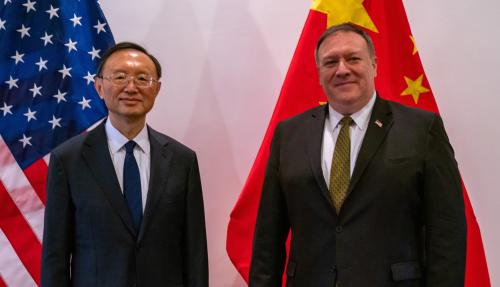
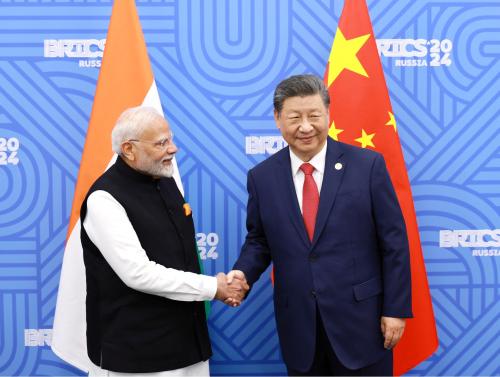
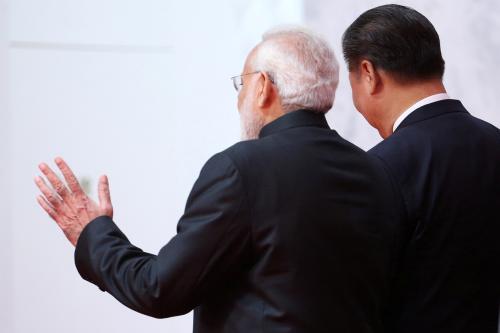
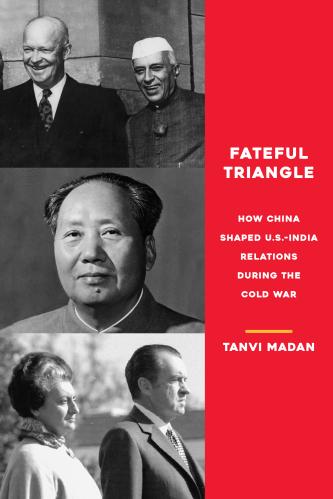

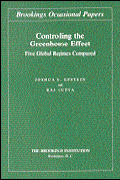

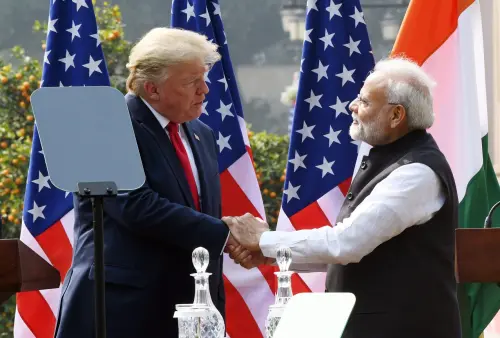
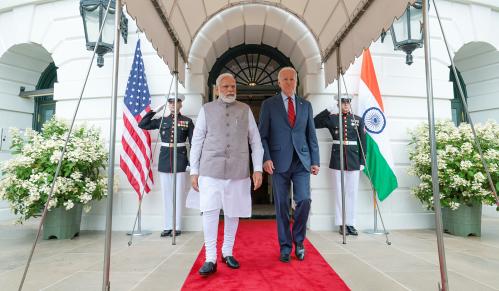
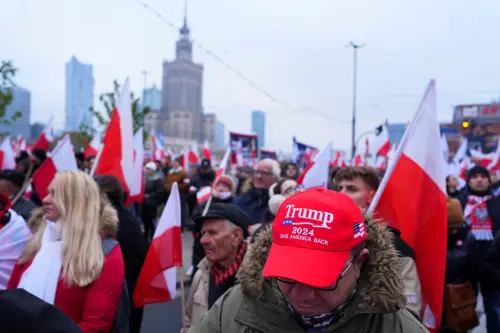
Commentary
TestimonyEmerging global issues: The China-India boundary crisis and its implications
September 9, 2020